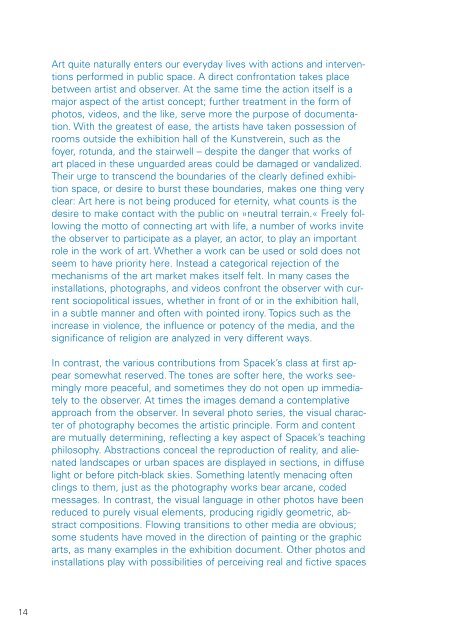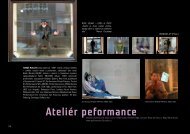klasse atelier - atelier performance
klasse atelier - atelier performance
klasse atelier - atelier performance
Sie wollen auch ein ePaper? Erhöhen Sie die Reichweite Ihrer Titel.
YUMPU macht aus Druck-PDFs automatisch weboptimierte ePaper, die Google liebt.
14<br />
Art quite naturally enters our everyday lives with actions and interventions<br />
performed in public space. A direct confrontation takes place<br />
between artist and observer. At the same time the action itself is a<br />
major aspect of the artist concept; further treatment in the form of<br />
photos, videos, and the like, serve more the purpose of documentation.<br />
With the greatest of ease, the artists have taken possession of<br />
rooms outside the exhibition hall of the Kunstverein, such as the<br />
foyer, rotunda, and the stairwell – despite the danger that works of<br />
art placed in these unguarded areas could be damaged or vandalized.<br />
Their urge to transcend the boundaries of the clearly defined exhibition<br />
space, or desire to burst these boundaries, makes one thing very<br />
clear: Art here is not being produced for eternity, what counts is the<br />
desire to make contact with the public on »neutral terrain.« Freely following<br />
the motto of connecting art with life, a number of works invite<br />
the observer to participate as a player, an actor, to play an important<br />
role in the work of art. Whether a work can be used or sold does not<br />
seem to have priority here. Instead a categorical rejection of the<br />
mechanisms of the art market makes itself felt. In many cases the<br />
installations, photographs, and videos confront the observer with current<br />
sociopolitical issues, whether in front of or in the exhibition hall,<br />
in a subtle manner and often with pointed irony. Topics such as the<br />
increase in violence, the influence or potency of the media, and the<br />
significance of religion are analyzed in very different ways.<br />
In contrast, the various contributions from Spacek’s class at first appear<br />
somewhat reserved. The tones are softer here, the works seemingly<br />
more peaceful, and sometimes they do not open up immediately<br />
to the observer. At times the images demand a contemplative<br />
approach from the observer. In several photo series, the visual character<br />
of photography becomes the artistic principle. Form and content<br />
are mutually determining, reflecting a key aspect of Spacek’s teaching<br />
philosophy. Abstractions conceal the reproduction of reality, and alienated<br />
landscapes or urban spaces are displayed in sections, in diffuse<br />
light or before pitch-black skies. Something latently menacing often<br />
clings to them, just as the photography works bear arcane, coded<br />
messages. In contrast, the visual language in other photos have been<br />
reduced to purely visual elements, producing rigidly geometric, abstract<br />
compositions. Flowing transitions to other media are obvious;<br />
some students have moved in the direction of painting or the graphic<br />
arts, as many examples in the exhibition document. Other photos and<br />
installations play with possibilities of perceiving real and fictive spaces



